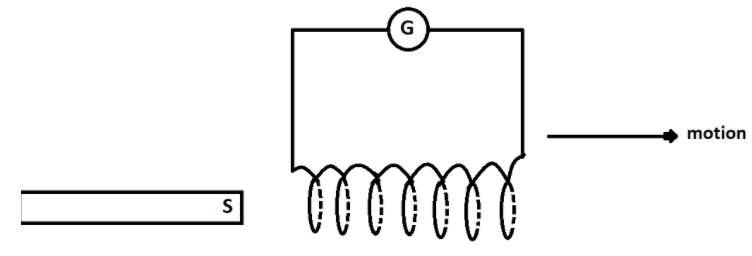
Deflection in the galvanometer.

A) Towards right
B) Left
C) No deflection
D) None of these
Answer
218.7k+ views
Hint: In order to solve this question, knowledge of the principle of solenoid and galvanometer is important. The concept that when a magnet is brought near the solenoid connected in a closed circuit will induce current in the solenoid is necessary. The direction of the flow of current would depend on which pole of the magnet is brought close to the solenoid. The direction of flow of current will be different for the North Pole and different for the South Pole. The direction of deflection of the needle in the galvanometer would depend on the direction of flow of current.
Complete step by step answer:
Here in this question, initially the given magnet is stationary which means it is not moving and in this condition there will be no deflection in the needle of the galvanometer. Hence, the pointer in the galvanometer reads zero.
But as the given in this question, that the south pole of the magnet is brought near the solenoid, when the south pole of the magnet comes towards the solenoid, the current starts flowing through the solenoid and the galvanometer shows deflection.
As the south pole of the magnet is brought closer to the solenoid, hence the direction of the flow of current would be clockwise direction which will make the galvanometer to show deflection towards the left.
Hence, option B, Left is the correct answer.
Note: Solenoid can be defined as the long cylindrical coil of wire with a large number of turns in it. It is important in a solenoid that the length of the solenoid should be greater than its diameter. When a magnet is brought towards the solenoid connected in a closed circuit, it induces current in the solenoid. If the north is brought close then the direction of flow of current would be anti-clockwise, if the South Pole is brought near the solenoid then the direction of flow of current in the solenoid would be clockwise.
Complete step by step answer:
Here in this question, initially the given magnet is stationary which means it is not moving and in this condition there will be no deflection in the needle of the galvanometer. Hence, the pointer in the galvanometer reads zero.
But as the given in this question, that the south pole of the magnet is brought near the solenoid, when the south pole of the magnet comes towards the solenoid, the current starts flowing through the solenoid and the galvanometer shows deflection.
As the south pole of the magnet is brought closer to the solenoid, hence the direction of the flow of current would be clockwise direction which will make the galvanometer to show deflection towards the left.
Hence, option B, Left is the correct answer.
Note: Solenoid can be defined as the long cylindrical coil of wire with a large number of turns in it. It is important in a solenoid that the length of the solenoid should be greater than its diameter. When a magnet is brought towards the solenoid connected in a closed circuit, it induces current in the solenoid. If the north is brought close then the direction of flow of current would be anti-clockwise, if the South Pole is brought near the solenoid then the direction of flow of current in the solenoid would be clockwise.
Recently Updated Pages
A square frame of side 10 cm and a long straight wire class 12 physics JEE_Main

The work done in slowly moving an electron of charge class 12 physics JEE_Main

Two identical charged spheres suspended from a common class 12 physics JEE_Main

According to Bohrs theory the timeaveraged magnetic class 12 physics JEE_Main

ill in the blanks Pure tungsten has A Low resistivity class 12 physics JEE_Main

The value of the resistor RS needed in the DC voltage class 12 physics JEE_Main

Trending doubts
JEE Main 2026: Application Form Open, Exam Dates, Syllabus, Eligibility & Question Papers

Understanding Uniform Acceleration in Physics

Derivation of Equation of Trajectory Explained for Students

Hybridisation in Chemistry – Concept, Types & Applications

Understanding the Angle of Deviation in a Prism

Understanding Collisions: Types and Examples for Students

Other Pages
JEE Advanced Marks vs Ranks 2025: Understanding Category-wise Qualifying Marks and Previous Year Cut-offs

Understanding Atomic Structure for Beginners

How to Convert a Galvanometer into an Ammeter or Voltmeter

Understanding Centrifugal Force in Physics

JEE Main Marking Scheme 2026- Paper-Wise Marks Distribution and Negative Marking Details

Degree of Dissociation: Meaning, Formula, Calculation & Uses




